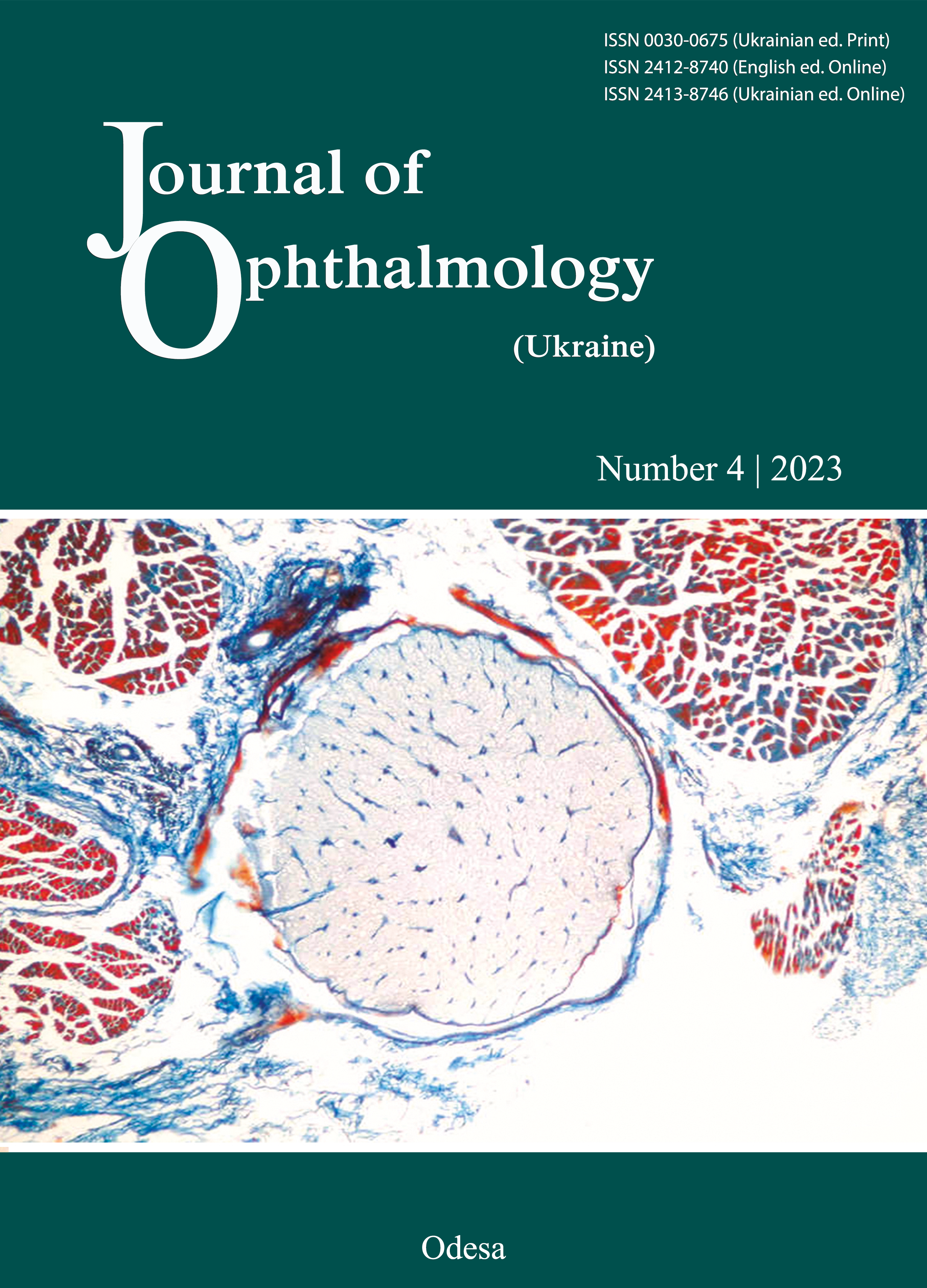Intrastromal corneal ring segment implantation in pediatric patients with keratoconus: long-term follow-up
DOI:
https://doi.org/10.31288/oftalmolzh20234913Ключові слова:
Keratoconus, Intrastromal corneal ring segments, visual acuity, keratometryАнотація
Purpose: To evaluate the long-term outcomes of Intrastromal Corneal Ring Segments (ICRS) implantation in pediatric patients with keratoconus.
Methods: Retrospective analysis of eyes with ICRS implantation in pediatric age. Uncorrected (UCVA) and best-corrected (BCVA) visual acuity, maximum and minimum keratometry (Kmax and Kmin), and corneal thickness at the thinnest point (CTTP) were evaluated preoperatively, 6 to 12 months after surgery, 5 years after surgery, and at the last follow-up visit (>10 years after surgery).
Results: Fourteen eyes (10 patients) were included. In 5 eyes all ICRS were explanted and in 1 eye, one of the segments was explanted. UCVA (p=0.028) and BCVA (p=0.028) improved 6 to 12 months after surgery and remained stable afterwards (p>0.999). There was a decrease in Kmax and Kmin 6 to 12 months after surgery (p<0.001 and p=0.012, respectively), with subsequent stability at the 5-year follow-up (p=0.736 and p=0.056, respectively). Kmax remained stable at the last follow-up (p>0.999) but there was an increase in Kmin (p=0.028). There were no changes in CTTP (p=0.097).
Conclusion: ICRS implantation seems to be a minimally invasive, and reversible procedure that leads to improvement of BCVA and keratometry readings. Despite this, the need for explantation increased overtime.
Посилання
Mukhtar S, Ambati BK. Pediatric keratoconus: a review of the literature. Int Ophthalmol. 2018;38(5):2257-2266. https://doi.org/10.1007/s10792-017-0699-8
Rabinowitz YS. Keratoconus. Surv Ophthalmol. 1998;42(4):297-319. https://doi.org/10.1016/S0039-6257(97)00119-7
Buzzonetti L, Bohringer D, Liskova P, Lang S, Valente P. Keratoconus in children: a literature review. Cornea. 2020;39(12):1592-1598. https://doi.org/10.1097/ICO.0000000000002420
Park SE, Tseng M, Lee JK. Effectiveness of intracorneal ring segments for keratoconus. Curr Opin Ophthalmol. 2019;30(4):220-228. https://doi.org/10.1097/ICU.0000000000000582
Kobashi H, Rong SS. Corneal collagen cross-linking for keratoconus: systematic review. Biomed Res Int. 2017;2017:8145651. https://doi.org/10.1155/2017/8145651
Feizi S, Javadi MA, Karimian F, Abolhosseini M, Moshtaghion S, Naderi A, et al. Penetrating Keratoplasty versus Deep Anterior Lamellar Keratoplasty in children and adolescents with keratoconus. Am J Ophthalmol. 2021;226:13-21. https://doi.org/10.1016/j.ajo.2021.01.010
Kanellopoulos AJ, Pe LH, Perry HD, Donnenfeld ED. Modified Intracorneal Ring Segment Implantations (INTACS) for the management of moderate to advanced keratoconus: efficacy and complications. Cornea. 2006;25(1):29-33. https://doi.org/10.1097/01.ico.0000167883.63266.60
Shetty R, Kurian M, Anand D, Mhaske P, Narayana KM, Sherry BK. Intacs in advanced keratoconus. Cornea. 2008;27(9):1022-1029. https://doi.org/10.1097/ICO.0b013e318172fc54
Alió JL, Shabayek MH, Artola A. Intracorneal ring segments for keratoconus correction: long-term follow-up. J Cataract Refract Surg. 2006;32(6):978-985. https://doi.org/10.1016/j.jcrs.2006.02.044
Baptista PM, Marques JH, Neves MM, Gomes M, Oliveira L. Asymmetric Thickness Intracorneal Ring Segments for Keratoconus. Clin Ophthalmol. 2020;16;14:4415-4421. https://doi.org/10.2147/OPTH.S283387
Abreu AC, Malheiro L, Coelho J, Neves MM, Gomes M, Oliveira L, et al. Implantation of intracorneal ring segments in pediatric patients: long-term follow-up. Int Med Case Rep J. 2018;11:23-27. https://doi.org/10.2147/IMCRJ.S151383
Ertan A, Ozkilic E. Effect of age on outcomes in patients with keratoconus treated by Intacs using a Femtosecond Laser. J Refract Surg. 2008;24(7):690-695. https://doi.org/10.3928/1081597X-20080901-08
Alfonso JF, Fernández-Vega-Cueto L, Lisa C, Monteiro T, Madrid-Costa D. Long-term follow-up of intrastromal corneal ring segment implantation in pediatric keratoconus. Cornea. 2019;38(7):840-846. https://doi.org/10.1097/ICO.0000000000001945
Ferrara P, Torquetti L, Ferrara G. Intrastromal corneal ring segments in children with keratoconus. Int J Keratoconus Ectatic Corneal Dis. 2017;6(2):45-48. https://doi.org/10.5005/jp-journals-10025-1142
Méndez EA, Roys N, Mejía ME, Plata MC, Rosenstiehl SM. Results of follow-up in pediatric keratoconus treated with intracorneal ring segments Implantation alone or in combination with corneal cross-linking. J Pediatr Ophthalmol Strabismus. 2022;59(2):118-127. https://doi.org/10.3928/01913913-20210719-02
Abdelmassih Y, el-Khoury S, Dirani A, Antonios R, Fadlallah A, Cherfan CG, et al. Safety and efficacy of sequential intracorneal ring segment implantation and cross-linking in pediatric keratoconus. Am J Ophthalmol. 2017;178:51-57. https://doi.org/10.1016/j.ajo.2017.03.016
Monteiro T, Alfonso JF, Freitas R, Freitas R, Franqueira N, Faria-Correia F, et al. Comparison of complication rates between manual and Femtosecond Laser-assisted techniques for intrastromal corneal ring segments implantation in keratoconus. Curr Eye Res. 2019;44(12):1291-1298. https://doi.org/10.1080/02713683.2019.1635165
McLintock CA, McKelvie J, Li Y, Hamada S, Lake D. Ferrara rings for visual rehabilitation in eyes with keratoconus and previous cross-linking using the Ferrara ring nomogram. Vision. 2021;5(4):45. https://doi.org/10.3390/vision5040045
##submission.downloads##
Опубліковано
Як цитувати
Номер
Розділ
Ліцензія
Авторське право (c) 2023 Castro C., Silva N., Pires S., Abreu A. C., Neves M. M., Gomes M., Oliveira L., Menéres P.

Ця робота ліцензується відповідно до Creative Commons Attribution 4.0 International License.
Ця робота ліцензується відповідно до ліцензії Creative Commons Attribution 4.0 International (CC BY). Ця ліцензія дозволяє повторно використовувати, поширювати, переробляти, адаптувати та будувати на основі матеріалу на будь-якому носії або в будь-якому форматі за умови обов'язкового посилання на авторів робіт і первинну публікацію у цьому журналі. Ліцензія дозволяє комерційне використання.
ПОЛОЖЕННЯ ПРО АВТОРСЬКІ ПРАВА
Автори, які подають матеріали до цього журналу, погоджуються з наступними положеннями:
- Автори отримують право на авторство своєї роботи одразу після її публікації та назавжди зберігають це право за собою без жодних обмежень.
- Дата початку дії авторського права на статтю відповідає даті публікації випуску, до якого вона включена.
ПОЛІТИКА ДЕПОНУВАННЯ
- Редакція журналу заохочує розміщення авторами рукопису статті в мережі Інтернет (наприклад, у сховищах установ або на особистих веб-сайтах), оскільки це сприяє виникненню продуктивної наукової дискусії та позитивно позначається на оперативності і динаміці цитування.
- Автори мають право укладати самостійні додаткові угоди щодо неексклюзивного розповсюдження статті у тому вигляді, в якому вона була опублікована цим журналом за умови збереження посилання на первинну публікацію у цьому журналі.
- Дозволяється самоархівування постпринтів (версій рукописів, схвалених до друку в процесі рецензування) під час їх редакційного опрацювання або опублікованих видавцем PDF-версій.
- Самоархівування препринтів (версій рукописів до рецензування) не дозволяється.












